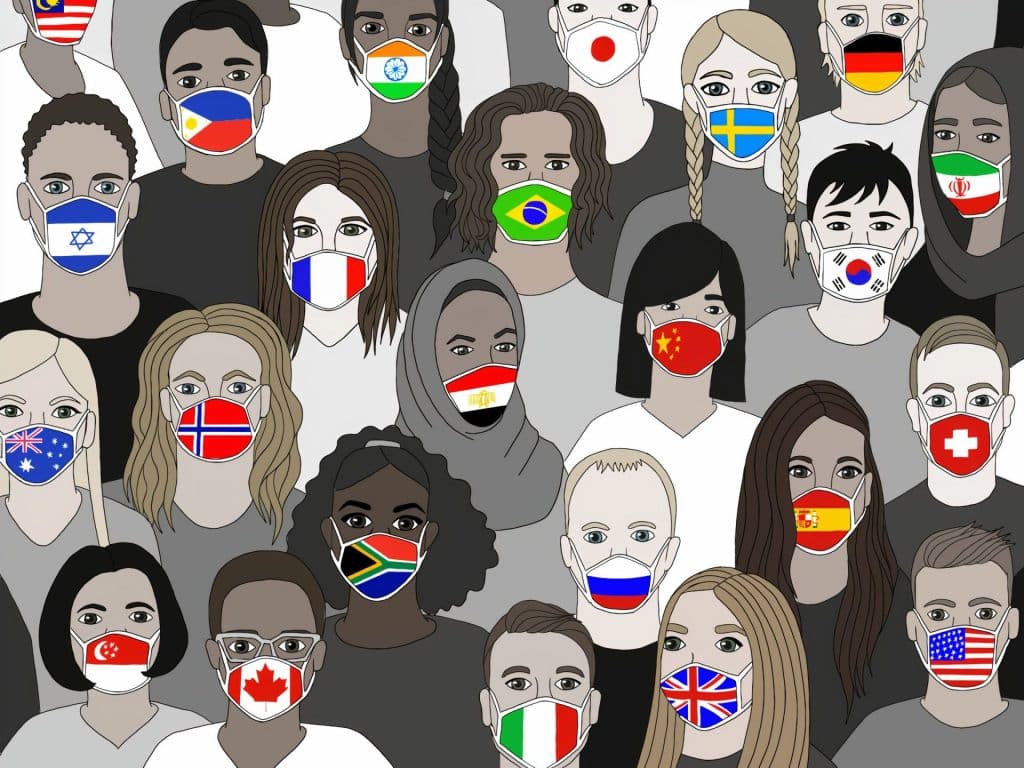Planning Marketing During COVID-19

Welcome to Part 2 of a 3-part blog series on COVID-19. This blog series is derived from a webinar we hosted in June with Hangar18 Design Continuum called, “Navigating Marketing Through COVID-19: Then, Now, Next”. In Part 1: “How COVID-19 is Changing Marketing”, we discussed consumer trends and how brands should plan about their budget. In this blog, we’ll be taking a look at what you can do now to plan for marketing during COVID-19. Topics we’ll cover: Put Society & Community First What Should My Creative Look Like? Why Should I Engage In Paid Media? What Channels Should I Invest In? TL; DR – What Have We Learned? Put Society & Community First NOW is the time to “help more”. It will pay social dividends immediately now and also down the road. There’s no doubt that it takes a lot of effort to build a good name. People more than ever want to vote with their dollars and support a good company that aligns with their values. Tip: Look closely inwards, understand the enormous value of your brand image. It doesn’t have to be exhaustive nor expensive to do it right. Do the little things that matter to enhance your reputation and turn it into a competitive advantage. Ultimately it will trickle down to loyalty — which is what we all strive for. In recent months, almost all of us have been socially-distancing but through that, we’ve found ways to connect with each other, online, on the street (six feet apart), on the phone, on message. In order to understand what “society-first” means we should practice these three things: Be Community-Focused.Show you care and don’t be afraid to say it. Show that you’re proud to be part of the community! Be Positive.People need hope and spend time with those that are more positive Ask Yourself: How Can I Help?Take the time to listen to your audience and plan accordingly. Photo by Alvaro Reyes on Unsplash What Should My Creative Look Like? We are living through a global public health crisis. It’s a time filled with fear of the unknown, concerns for our own health and the health of those closest to us, as well as billions of people we don’t know, but whose fate is intertwined with ours. Look inwardly to your brand strategy and what you were saying pre-Covid, and then think about how to adjust your brand voice/brand personality/ brand message. Your brand has to be sensitive to the new environment that COVID-19 has steered us into. Refer to your brand essence: What drives your company? What emotion does it make people think of? How can you continue to leverage that, and show care? Demonstrate that you care, by relating to the moment. Remember to spread positivity and don’t be afraid to make it more real. During strict social distancing lockdown, A&W ran a TV spot commercial and it really stood out to us. It was bare bones yet compelling. The A&W spokesman featured in their usual commercials was delivering an ultra simple cell phone selfie video. It made the audience feel that, wow, we are all in this together and ultimately feel good about A&W as a company! As you can see, it’s a tough time, so please remind yourself that this is not the time of hard selling. Instead, consider volunteering or collaborating with a local charity and making a positive impact in your community. Show that you care through your actions. Remember, your target audience is shopping around for companies that show positive reinforcement in the community. How Do I Stay Positive and Transparent in My Creative Communications? Communicate openly and honestly Keep it real. Keep it simple. Tone — does the tone of the creative match the context of the situation? (no need for a cool tempo track) Demonstrate that you care/relate to the moment and in your own way, spread positivity. Photo by Alvaro Reyes on Unsplash Why Should I Engage in Paid Media? There are three main things we need to focus on when considering investing in paid media: flexibility, control, and visibility. Consumer spending trends are shifting fast and drastically and COVID-19’s “new normal” is changing too, paid media is flexible to adapt. Unlike traditional media, digital ad format doesn’t lock your investments in. You’re able to switch and tweak your campaigns to best optimize for the current situation. This gives you control to make adjustments quickly to mirror your consumers’ demand. Because of the social distancing and stay-at-home orders, we are seeing increased engagements of consumers on various channels: 70% increase in web browsing time 63% increase in TV watching 61% increase in time on social media 46% increase in online news sites visits Interest in YouTube grew 29% in March 2020 Free on Demand (FOD) ad-supported streaming video consumption grew 21.2% year over year Photo by dole777 on Unsplash What Channels Should I Invest In? In the previous section, we saw large increases in the amount of web browsing time, tv watching, social media and other social channels, and news sites. Did you know that since COVID-19 started, desktop usage is up over mobile? Facebook +27% Netflix +16% Youtube +15% You should focus on channels that: Have sophisticated metrics that allow you as the marketer to see in real-time the detailed results of campaigns Don’t necessarily need a large financial investment to see good results Attract high-interest consumers with high-conversion potentials Have geo-targeting capabilities Social distancing has resulted in a rise in interactive channels. The recent trend shows that Interactive channels are outperforming traditional display channels: Twitch: +19.7% TikTok: +15.4% These channels in particular tend to be focused on younger demographics, but the statement of increased interactivity can be broadly applied. Wondering what channels your business should be investing in? See our blog, “How to Choose the Right Advertising Channel” or, simply contact us today! There you have it for what you can do in the “now” through this pandemic when it comes to marketing. Head on over to the last part of our COVID-19 blog series, “Post-COVID-19 Marketing –
How COVID-19 is Changing Marketing

2020 has been quite the year so far and COVID-19 definitely threw everyone in for a loop! These are challenging times for marketers and consumers alike. The world is changing and so has the landscape of marketing. We wanted to share some insights and tips for businesses and how they can step back into marketing during this pandemic. We recently collaborated with our creative partner, Hangar18 and hosted a webinar called, “Navigating Marketing Through COVID-19: Then, Now, Next”. The webinar covered so many great topics, so we decided to break it up into a 3-part blog series for easier consumption. How COVID-19 is Changing Marketing Planning for Marketing During COVID-19 Post-COVID-19 Marketing – What to Expect? So, let’s get started! Start reading by scrolling down or choosing a topic: Historical Learnings Trends & Shifts in Consumer Behavior FAQ on Budget & Costs Should We Cut Our Marketing Budget? What If I HAVE TO Cut Costs? If We’re On a Restrictive Budget, What Channel Should We Run On? How Much Does It Cost To Advertise Online Right Now? Corporate Social Responsibility TL;DR – What Have We Learned Photo by Tai’s Captures on Unsplash Historical Learnings When we began research on this topic, we realized that the landscape of marketing was similar to the trends that had happened during the 2008 financial recession. This graph highlights the statistics of consumer spending in Canada (blue) and the United States (US). You can see that both countries were significantly impacted by the recession in 2008 and through to 2009. However, you can also see that consumer spending had rebounded: To pre-recession levels just over one year later in Canada and eventually to a level higher than pre-recession by January of 2010 Canadian consumers were a bit faster in rebounding compared to their American counterparts. Given the case rate of Canada versus the US, we can anticipate observing a similar trend in post-COVID times. Now with a frame of reference on how we should be approaching marketing during COVID-19, our efforts should look more like they did during the recession. Trends & Shifts in Consumer Behavior EY had shared an interactive graph that categorized consumers’ behavior into separate segments and predicted how they would transition post-COVID-19.They categorized consumers into 4 spending categories during COVID-19: Save and Stockpile (35%) Cut Deep (27%) Stay Calm and Carry On (26%) Hibernate and Spend (11%) EY also identifies five categories consumers are predicted to fall into post-COVID: Get to Normal (32%) Cautiously Extravagant (25%) Stay Frugal (21%) Keep Cutting (12%) Back with a Bang (10%) Keeping these statistics in mind can help us to predict the likely trends as we emerge more holistically from COVID-19. EY highlights two significant numbers: This reflects a fundamental shift in consumer behaviour. Photo by Anastasiia Chepinska on Unsplash FAQs on Budget & Costs Should We Cut Our Marketing Budget? Most companies have asked themselves regarding their budget during these tough times: “Should I cut or should I spend?” “If I cut, where do I cut?” “If I spend, where do I spend?” Think about it. Sales are down because of the virus. The Marketing team is now the one that is most exposed to your consumers via online, social and other forms of media, having the most direct contact with your audience. Therefore, it’s absolutely imperative that resources are not cut from marketing budgets. What If I HAVE TO Cut Costs? Evaluate your company’s expenses and identify which expenses belong in the “enhancing revenue” category. Marketing is fundamental in driving brand awareness and sales, so you should at least protect your core marketing investments. A lot of organizations are wondering where to cut spending during tough times. Ask yourself and the team: How much you are spending and where, on which channels? What products and categories are vital to the company’s long-term health? Tip: If you’re cutting investments, have a strategy and don’t cut across the board/evenly. Rethink investments in areas where your product/service can stand on its own or where user demand has changed. You should not be cutting your budget blindly. Instead: reassess, recalibrate and pivot! We see that the organizations that invested in their marketing efforts rebounded faster than those who didn’t. As an example, there was a study done in 2015 by the School of Hotel Administration at Cornell University called: “Winners and Losers during the Great Recession: The Positive Impact of Marketing Expenditures”. The study compared different groups revenue and profitability with different marketing expenses during the recession. The results showed that those who invested in marketing efforts during the recession came out ahead of those who didn’t. The data lead to the conclusion that by “investing” in marketing, especially in tough times, can achieve a payoff. If We’re On a Restrictive Budget, What Channel Should We Run On? The answer would be dependent on your business’ objective and target demographic. If your objective is Brand Awareness, it would be Display Ads.If your objective is driving conversions, it would be Search Ads with a focus on Lookalike and Retargeting audiences. Do note that having a mix for conversion is important. How Much Does It Cost To Advertise Online Right Now? COVID-19 is making paid ads become cheaper. Ad networks make money through an auction system. They need businesses to drive up the CPC. Because there’s less businesses advertising right now, the price has lowered. There isn’t much competition for the inventory so the CPC decreases. The virus is causing us to spend more time online. Even Netflix is slowing down there streaming quality to help. Traffic on the web is up, but there are fewer advertisers, which means ads are cheaper. Learn more about our advertising services Corporate Social Responsibility With the current societal landscape in the time of the coronavirus, consumers are telling us with their wallets that: What we do in the community matters They will support businesses that help others This trend has been growing naturally year after year. But with the introduction of the pandemic, the importance of Corporate Social Responsibility (CSR) has been
Will Google Removing Third-Party Cookies Impact My Business?

When you first enter a website whether on your desktop or mobile phone, you are almost always likely to be welcomed with a pop-up window that is asking for you to agree to the website’s use of cookies and also have a link to their company’s Cookie Policy. Yes, we will be talking about cookies today. Not the delicious, gooey kind, but cookies that we interact with on the internet, almost on a regular basis. You might have heard, or are just learning that Google is planning to phase out third-party cookies completely in the next two years. Editor’s Note: Google’s decision to remove third-party cookies will directly impact advertisers within the ad tech space. Advertisers get cleaner, more accurate data and users get more privacy — it’s a win-win situation for everyone!. How does this impact internet users? What about programmatic advertising?What can your business do to adapt to this change? In this blog, you will learn: Difference between First-Party and Third-Party Cookies Why Google is Removing Third-Party Cookies What Will Digital Advertising Be Like Without Third-Party Cookies How Does This Impact Programmatic Advertising How Will This Impact Your Business and Advertising What Can You Do as a Business to Navigate This Change Right Now What is War Room’s Take on This Before You Go…What Have We Learned? Let’s take a walk through and get a better understanding! Photo by Erol Ahmed on Unsplash First-Party VS. Third-Party Cookies First-Party Cookies This is the type of cookie that was described above, it’s the type that greets you when you enter a website. This means the company is getting your consent to be tracked by the cookies on their website. Why? This allows the website to collect data for analytics and save your information, such as your shopping cart, password etc for easier access when you return to the site in the future…all of these are dedicated to creating a better user experience. Third-Party Cookies You’ve most definitely come across this type of cookie as well. You might have been looking up your dream vacation to Italy before the COVID-19 pandemic hit, and now you’re seeing ads for cheap flights to Italy everywhere you go on the internet! Now how do they do that? Online marketers, advertisers and social media platforms like Facebook are the ones that utilize these third-party cookies to track users on websites you may not be currently on but had previously visited. Why? This allows companies to gather your data when you’re on their website and to better understand your browsing habits, shopping behavior etc so they can retarget and serve you specific advertisements that are relevant to you and your lifestyle. The general consensus is that first-party cookies are fine and dandy because we all want a better user experience online, but third-party cookies can be a bit too invasive. Why is Google Phasing Out Third Party Cookies? Now we know the differences, let’s take a look at why Google wants to phase out third-party cookies. In January 2020, Google announced that they will be phasing out third-party cookies completely in the next two years. This isn’t a sudden decision on a whim. Remember the Facebook drama in 2018 with Cambridge Analytica mining and selling people’s data without their consent for political advertising? User data and privacy have since then become a concern for many internet corporations. Apple’s Safari has Intelligent Tracking Prevention (ITP) and Mozilla Firefox has Enhanced Tracking Protection technology in place. Having these measures in place means the browser prevents advertisers from tracking user’s internet habits. Firefox even highlights this function as one of their biggest differentiators: Google announced that their intention is to phase this out by 2022. This is a trend these corporations are implementing for ethical reasons. In their own words: “Users are demanding greater privacy–including transparency, choice and control over how their data is used–and it’s clear the web ecosystem needs to evolve to meet these increasing demands…We believe that we as a community can, and must, do better. Google consists of 60% of global browser market share and this is why they will be taking their time to best plan out the scope of change and implementations. They had proposed an alternative to third-party cookies, called the “Privacy Sandbox”. The function would be to move and store all user data into Chrome’s browser. This means that data is stored autonomously into the device. Experts say this could be the new golden standard for privacy. What Will Digital Advertising Be Like Without Third-Party Cookies? Marketers and companies alike are predicting this to completely overhaul the online advertising world as we know it, some even call it the “cookie apocalypse”! A lot of online advertisements’ infrastructure is based around cookies. It’s how most businesses and advertisers collect data, track and retarget consumers, which may impact their line of sales. So this shakeup definitely calls for brainstorming of a new approach and strategy. However, it’s important to note that yes, even though some aspects of marketing and advertising will be impacted (specifically audience-targeting), the majority of marketing tactics will remain the same. Being in business, it’s exciting to take on new challenges and work on overcoming obstacles. Don’t worry, you are not alone. Because of this change, the Interactive Advertising Bureau (IAB) is spearheading “Project Rearc” which calls for the online advertising community to work together to re-architect the digital marketing industry in a post-cookie world. You might have heard of the IAB as they are the global trade organization in digital advertising, which introduced in 2018 and enforces the General Data Protection Regulation (GDPR). Not only that but there have also been new acts and laws bought in since then to help with data protection. The NY shield act has been a useful contributor toward protecting New York residents and the data they provide to businesses. The SHIELD act or otherwise known as Stop Hacks and Improve Electronic Data Security Act was bought in and became fully enforceable in March 2020. It imposed greater data security requirements for companies that collected information on NY residents and has helped provide better overall breach
What Boycotting Facebook Ads Means For Your Business

You may have heard in the news recently that big brands are boycotting Facebook and pulling their ads off of the social media platform. Why are they doing this and how will it affect your business’ advertising? Let’s break it down. How Did The Boycotting of Facebook Ads Come About? At the end of May 2020, the killing of George Floyd, an unarmed African-American man during his arrest was captured on video and caused an uproar in demand for social justice. This has propelled the Black Lives Matter movement more than ever. In light of the movement, , civil rights organizations and advocacy groups launched a petition called: “Stop Hate For Profit”. They are asking for a safer internet experience for all. In support, big companies like: Unilever, North Face, Starbucks, Hershey’s, Ford and hundreds of others have boycotted Facebook and Instagram are pulling millions of advertising dollars from Facebook. These companies are demanding that the network should be more aggressive and proactive in monitoring and policing hateful content. Facebook is the biggest social media platform in the world and 98% of its revenue comes from advertising, so the companies’ goal is to directly impact Facebook’s revenue stream and force Facebook to do more. Past Learnings From Youtube Advertising Boycott If you look at a similar case, a few years back, Youtube had also faced a full-scale advertising boycott as well. Advertisements from Coca-Cola, Amazon were being placed next to Youtube videos that were racist, homophobic, anti-semetic or even pedophiliac. These big companies pulled all of their advertising to protest and call for Google to take action and fix this problem. Google has since then created technology and tools for advertisers and brands to have more control and insight into where their ads are placed. They also implemented more human reviewers and AI-driven filtering systems for content. Editor’s Note: Programmatic advertising agencies like War Room use proprietary algorithms and technologies to assist in digital media buying. We are able to hyper-target audiences and only have your ads show for the most relevant, potential consumers. This allows for transparent control of ad placements. Photo by Mike Tyler on War Room Inc However, there is no doubt that social media platforms are where the consumers are at. There are 500 hours of video uploaded to Youtube every single minute. 1 billion hours of videos are consumed worldwide every single day on Youtube. Social platforms are accessed by billions of people, therefore they fundamentally have the responsibility to create a safe environment for users and combat bigotry and violent extremism. Conversations need to happen and it takes constant communication back and forth to create steps towards change. What Does It Mean For Your Business and Advertising? As of 2020, Facebook has 2.6 billion monthly active users, there is no doubt that it is a monolithic platform for online advertising. We don’t expect to see Facebook’s revenue take too much of a dip from this boycott. A major way ad networks like Facebook make money in advertising are through ad auctions. Because lots of big players are choosing to boycott Facebook ads, it has freed up a lot of the ad space. It’s a great opportunity for medium and small businesses to take advantage as the costs may be lower due to less competition for inventory. It’s definitely up to you to see if boycotting Facebook ads aligns with your brand’s business goals and values. We see the opportunity to continue leveraging Facebook’s platform of direct access to consumers while being socially accountable. Convey your brand values through sincere messaging. You need to be community-focused, always think of the big picture and how your brand relates to it. What can you offer and spread positivity? Be conscious of the societal climate by reflecting and open-minded to learn. Think: How can we be better together and do good? Keeping your brand in check by consistently listening to different voices in the community. That is the way to continuously adapt and improve in today’s marketing landscape. Are you looking to up your advertising game? War Room’s Advertising Institute has got you covered! What Did We Learn? In light of the recent Black Lives Matter movement, Civil rights organizations and advocacy groups have launched a petition called “Stop Hate For Profit”, which is asking Facebook to be proactive in monitoring and policing hate speech. Many big corporations have joined the movement and are boycotting Facebook, pulling all of their advertising budget which accounts for millions of dollars. Almost 98% of Facebook’s revenue is from advertising, so this will directly impact Facebook’s bottom line and these companies hope to seek action for change. What does this mean for businesses and advertising? It’s a good time to review one’s own company policy and culture, to be reflective. Even though big advertisers have stopped advertising on Facebook, there are still over a billion Facebook daily users so the market is still there. In fact, there is probably less competition on Facebook Ads currently. Medium and small businesses should take advantage of the open market and potentially lower advertising costs. However, it is also important to be socially accountable. It is totally up to you to decide whether your company would like to participate in the boycott or not, but there is no doubt that it is quintessential for businesses to be kind, to be receptive to listening and learning and having a community mindset. That is the way to continue to adapt and improve in the marketing industry!
